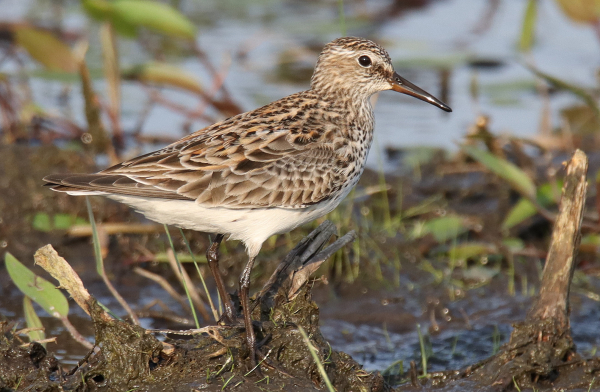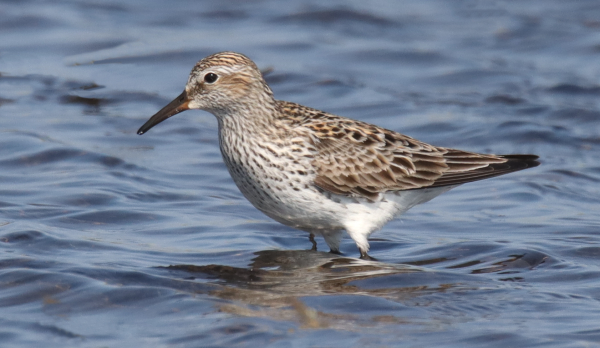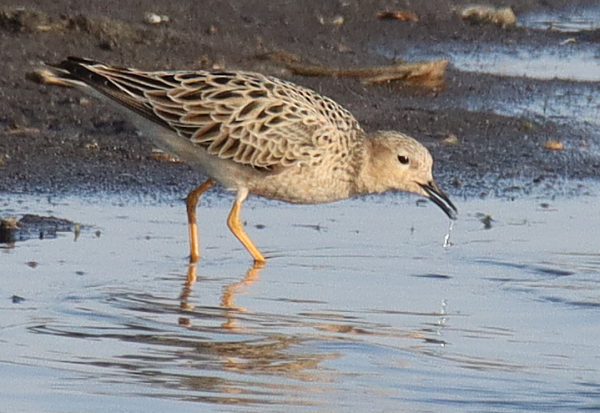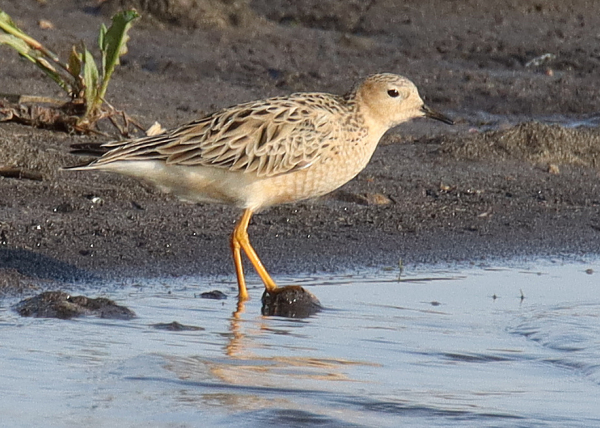Expecting this to be the best warbler week of spring, Mother Nature had another surprise in store. I’ve long been hoping for a spring sighting of a special sandpiper that migrates across the Great Plains, starting from wintering areas in northeast Argentina, crossing the Amazon basin, the Yucatan Peninsula and following the Gulf Coast to Texas, then aiming straight north across the eastern Great Plains to eventually end up on the Arctic tundra of northernmost Alaska and Canada, including islands north of mainland Canada. Yes, Buff-breasted Sandpipers migrate about 5,000 miles each spring, one of the longest migrations among North American birds.
Presumably some Buff-breasted Sandpipers make migration stops in my region of North Dakota, but my last sighting of the species was fully 22 years ago! Having seen other exciting Arctic-nesting shorebirds occasionally, including small flocks of Hudsonian Godwits, a pair of Black-bellied Plovers, a few Ruddy Turnstones, and a flock of American Golden Plovers over the years, I knew there was the remote potential of seeing a few Buff-breasted Sandpipers some day, some May, but without luck year after year. Oh how I would enjoy getting a quality photograph of this rarely encountered species one day.

Consumed by warbler and oriole attentions, migrating shorebirds weren’t really on my radar this May, mostly because the water levels are so deep with limited shorelines or mudflats that there has been little evidence of Arctic-nesting shorebirds stopping, even in traditional shorebird hotspots like Long Lake Refuge and McKenzie Slough.
All that changed last Thursday when Arctic-nesting shorebirds surprised me in a big way, one species after another. On my way home from a wind-blown birding drive, I stopped to take a closer look at some sandpipers at a shallow water basin surrounded by the fertile black soil of a newly planted ag field. Although small sandpipers are never easy to identify until you get familiar with them, I could see White-rumped Sandpipers and Baird’s Sandpipers were active along black soil shore. But then a couple larger tan sandpipers with yellow legs caught my attention: Could they be Buff-breasted Sandpipers?
Just then, a pair of Black-bellied Plovers flew low above the far side of the shallow wetland, and considering I had only seen Black-bellies once before in the area, Buff-breasts seemed all the more possible. I reached into the back seat for my field guide and verified my hunch – Buff-breasted Sandpipers! These larger birds were lively, drinking and bathing. And that’s when a Ruddy Turnstone flew into my view nearby, continuing to the far side of the wetland’s shore, another species I have only seen once before in the region, but never within 4 miles of my office – very exciting.

The Buff-breasted Sandpipers continued to hold my attention; how I wished I could photograph them at close quarters. I immediately took a few documentary long-range photos, but imagined this could be the big photo opportunity that I’ve been envisioning for many years. In short order the Buff-breasts took flight, then settled back with me hoping one or some would land nearer my end of the elongated water body.
What an exciting natural event to witness, a likely quick stopover by a number of species of Arctic-nesting shorebirds. But gosh, how I wish I could get some closer photos of the Buff-breasted Sandpipers! Maybe tomorrow? Ya never know; who would have guessed I’d see these birds tonight?
Shorebird Stopover

The Buff-breasted Sandpipers tended to stay along the black shore, making the best opportunity to emphasize their black bill while they were drinking, when the bill stood out against the sky-blue water. The quality of the Buff photos is not as good as the above sandpiper images, but they are good documentary photos (600mm zoom, f-7 aperture, 1/640 shutter speed, ISO 400).
|
Friday morning I drove to the sandpiper wetland to check it for Buffs, Ruddys, and Black-bellies – ha. I figured they were likely in Canada by now, but there were 4 Franklin’s Gulls on hand. I decided to take an extended drive to see if I could find other shorebirds during their local migration stop, which produced White-rumped, Baird’s, and Semipalmated Sandpipers at 2 small seasonal wetlands a couple miles away. These small sandpipers provided a number of pleasing photos and I could only wish there were Buff-breasts among them at close quarters.
That evening I checked back to the 2 Buff-breasted Sandpiper shoreline, and to my delight, 4 Buffs were present, along with 3 Ruddy Turnstones on the opposite shore. All the birds were too far away for photos, but that evening I had a chance to observe and understand their behavior more. Essentially, I verified what I imagined during the previous night’s observations, while adding more observation time to feel more confident about my impressions. Buff-breasted Sandpipers were coming to the edge of the shallow wetlands only briefly to drink, and sometimes bathe; then they returned to the surrounding newly planted ag fields to forage for insects.
In some cases the birds flew out of sight in pairs or small flocks, but I was able to follow a few Buffs with binoculars and see them land in the midst of a field. There they walked slowly, usually in an upright position, presumably searching for insects, and bending over to pick up bugs regularly. I also saw some Buff-breasts walk from the fields to the wetland edge, without flying in; at the shoreline they drank, before returning to the field on the wing.
I was especially excited to find some Buff-breasted Sandpipers were still in the area, and I now had better information to try to position my mobile blind and conjure the patience to wait for one or more of the species to access the shore closer to my car. Saturday after 5:30pm I was in position and crossed my fingers that some Buff-breasts remained in the area with an ambassador or 2 among them (“ambassadors of their species” are individual birds that provide excellent photo opportunities when others don’t).
I’m not sure what I was doing, but soon after arriving, when I looked up there was a flock of 5 standing in line along the shore, taking drinks, fairly close (but not really). I photographed them as best I could, trying to take photos when their bill reached toward the water, so the black beak would stand out against the blue water. No bathing for this flock though, which took flight after drinking.
Another group of 8 flew in 15 minutes later, drinking along the shore, then moving into the water with 5 bathing together – quite a sight, but photos didn’t work out well. Soon they flew off in groups of 5 and 3. In flight the Buff-breasted Sandpipers were really fast, propelled on long sleek pointed wings as they sliced into the strong south wind.
I wanted to wait another 10 minutes, until 7pm, and a couple minutes into that wait, 2 Ruddy Turnstones flew in, followed by a big influx of sandpipers, probably Baird’s and White-rumps. But suddenly a few larger sandpipers flew in, and one landed closer than any others had. I knew it was a Buff-breasted Sandpiper and I took a couple photos immediately as it seemed to walk a few steps in my direction. As it turned to the side, I managed my 2 best photos as it took a couple long steps toward the water, then stopped.
Sunday evening I felt content that I was ready to get my best photos during what had become a 4-evening photo session, and during the hour before a low storm front moved in to cover the sun, I enjoyed great views of Buff-breasted Sandpipers. They came in 5 groups, about 10 minutes apart, starting with 2 that appeared closer than any others. They were joined by a third Buff, they drank, and flew away. Next a Buff-breast flew in with 3 White-rumped Sandpipers, which was interesting in itself. It drank and left without the White-rumps. Two more Buffs followed, again joined by a third; and next I saw a flock of 5 land 50 feet away from the water’s edge that foraged in the newly planted field without coming to drink or bath.
To top off the night, as thunder started to rumble, 2 Buff-breasted Sandpipers landed close, followed by 2 more, and in a moment 8 had landed in a fairly tight flock that began to drink. I photographed with a renewed level of excitement, until a flash and loud bang of lighting flushed the sandpipers, and it was clearly time to head back to the office. Monday, there was no sign of Buff-breasted Sandpipers; as was the case Tuesday, so my luck ran out, but fully 3 days after I really expected this photo episode to end. It was a memorable time that I wanted to chronicle and share with you; after all, who else had a chance to photograph Buff-breasted Sandpipers this spring?
Photo Challenges

Even though the black bill doesn’t stand out well against the black background, the plumage and shape of the Buff-breasted Sandpiper is distinctive in a way that makes them truly attractive birds that we get to witness far too rarely along their long migration route (photo info: 600mm zoom, f-8 aperture, 1/640 shutter speed, ISO 400).
|
There were 2 primary challenges to photographing the sandpipers – the background and distance. As always, an open background can do a lot to provide a simple focus on your subjects, but especially in the case of the Buff-breasted Sandpipers, the black soil background made it hard to keep the birds’ bill from vanishing into the black background. The best I could do to avert “losing” their bill was to emphasize taking photos when the sandpipers bent over to drink water in the shallows. Then the black bill would be highlighted by the surrounding sky-blue color reflected by the water. It certainly would have been nice if the birds had waded a little farther into the water so their head and body were surrounded by the sky-blue water color, but their behavior didn’t provide that look. The drinking movements did show something of the birds beyond a simple portrait – a little action always adds to bird photos.
Distance was the biggest challenge when photographing the Buff-breasts. The birds were quite wary; they were always aware of my white car parked in the open, and often landed a distance down the shoreline. Perhaps because of the wind, and perhaps because they became more trusting of my parked blind, the last 2 evenings some Buffs landed almost as close as possible. As it was, I could only park so close without getting stuck in the gumbo mud, and that obviously wasn’t an option; plus the birds probably wouldn’t have accepted a much closer approach. I did search for other locations where Buff-breasted Sandpipers might be visiting, but found none.
Distance was the deciding factor relative to the quality of photos I was able to take, leaving me with only documentary-quality photos in the end; but that was a huge breakthrough for me. Just seeing the species was such a thrill, but seeing them over a series of days that provided long-range photo opportunities and the chance to study their behavior was really satisfying, as well as challenging and fun. Certainly a week ago seeing Buff-breasted Sandpipers was almost beyond imagining and far beyond my focus, although I’ve hoped for the chance for decades – Hoooray!
Now that the Buff-breasts have continued their migration north, I’m excited to share these photos such as they are, partly because I’m now confident that I will meet individuals of this species again, and I predict it will be relatively soon. It won’t take another 22 years; maybe next year will be the magic May when I get the breakthrough I believe will come some day when I get close to some Buff-breasted Sandpipers in beautiful spring sunlight. Now, on the cusp of June, it will be especially exciting to see all the birds this special month that is shared by spring and summer will offer. Keep your camera within reach and Good Luck!
Article and photographs by Paul Konrad
Share your bird photos and birding experiences at editorstbw2@gmail.com